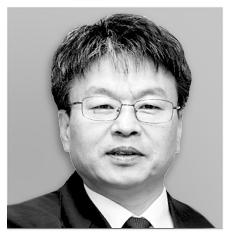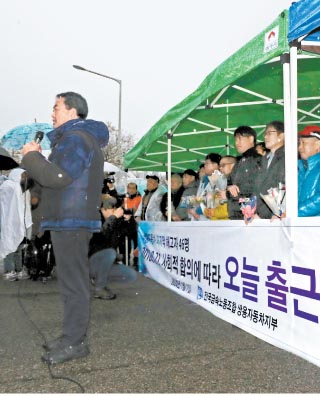Moon or the markets?

The author is a columnist of the JoongAng Ilbo.
The Law of Jante is a set of social norms that underpin Scandinavian societies like Sweden, Norway and Denmark. Janteloven is a code of conduct requiring self-restraint for the good of society. The bottom line of the 10 rules is not to think you are better than others: “You’re not to think you are any smarter than we are, more important than we are, or think you can teach us … so on.”
When President Moon Jae-in visited Sweden last June, he was met by his host Swedish Prime Minister Stefan Löfven at the Grand Hotel Saltsjobaden near Stockholm. The hotel is where the Saltsjobaden Agreement was signed among labor unions in 1938 in the wake of the Great Depression. The rules on industrial action have become legal principles for conflicts among labor market forces. Employers and unions would have come to such a pact because of the Janteloven gestalt. The model was adopted by the Dutch in the Wassenaar Arrangement in 1982 and by Germans in the Hartz reforms of 2003.
Since the agreement, Swedish unions no longer regard management as their enemy. In collective wage bargaining, they consider wages and price competitiveness of neighboring countries, as well as imbalances among domestic workers. German unions join forces with their employers to make headway in the fourth industrial revolution. Wim Kok, a union leader who led the landmark labor deal, went on to become the finance minister and prime minister of the Netherlands. Such flexible labor relationships have helped northern European countries bring down imbalances in wages and led to a collaborative wage system to ease inequalities.
Policymakers, labor and management reached a settlement over laid-off employees of SsangYong Motor last September. The mood at the Pyeongtaek plant of the carmaker, however, remains icy. The last 46 laid-off employees were hired back, but they cannot return to factory lines due to a lack of work. They were registered as employees after signing a labor agreement but nevertheless must enter the factory site as visitors. They are on leave indefinitely and must live on 70 percent of their basic salaries.
The reinstatement of SsangYong Motor employees was one of President Moon Jae-in’s top campaign promises. Moon Sung-hyeon — head of a presidential tripartite committee among labor, management and the government — discreetly met with SsangYong Motor CEO Choi Jong-shik to ask for a restoration of the laid-off workers. Choi, a recruit from Hyundai Motor to help turn around SsangYong Motor, was a classmate of the committee head when they studied at Seoul National University’s business school. But Choi turned down Moon’s request, saying the company just barely managed to pull out of a deficit and still could not afford more workers.

Reinstated workers at SsangYong Motor stage a rally to protest the company’s decision to put them on unpaid leave indefinitely. [SSANGYONG MOTOR]
While campaigning in 2012, presidential candidate Moon Jae-in promised families of laid-off employees thorough investigations into the violent raids on protests by SsangYong workers. During his second campaign for president in 2017, Moon once again raised the SsangYong Motor affair and vowed to toughen dismissal guidelines for companies across the board. He mentioned Han Sang-kyun — a former head of the militant Korean Confederation of Trade Unions imprisoned for orchestrating the chained protests by SsangYong workers. Moon tweeted about his “deep joy” when an agreement was reached to reinstate the workers last year.
But the future of the motor company and its employees remains murky. SsangYong Motor incurred deficits for 11 straight consecutive quarters. Last year, its red ink widened from 27.8 billion won ($23.2 million) in the first quarter to 49.1 billion in the second and 105.2 billion in the third. The full 2019 loss is estimated at around 400 billion won. Its stock price is dirt cheap at 2,000 won per share — down a whopping 90 percent from 10 years ago, when it was bought by the Indian group.
The SUVs made by SsangYong Motor have been challenged by the Palisade of Hyundai Motor, Mohave of Kia Motors and Traverse of GM. Its compact SUV Tivoli lagged behind rivals Kona and Venue of Hyundai, not to mention Stonic and Seltos of Kia Motors. It does not have a strong model in the pipeline. The export environment has been unfavorable. Shipments to Russia and Iran have been stopped by U.S.-led sanctions, and exports of diesel models to Europe have become difficult due to stronger emissions regulations.
SsangYong Motor’s financial state is not good. Its debt-to-equity ratio hit 285 percent last year, up 80 percentage points from the previous year. It may not be able to pay debt that is maturing this year. Last year, the management cut the number of executives by 20 percent and salaries by 10 percent. This year, it will freeze wages and cut 200 percent of regular bonuses, as well as cutting a year-end bonus — a package agreed to by 94 percent of its union members.
With the remarkable restructuring in progress, Pawan Goenka, Mahindra’s managing director, on Jan. 16 asked the main creditor Korea Development Bank (KDB) for a debt rollover along with a fresh loan of 270 billion won for SsangYong Motor. He went on to meet the vice chair of the Presidential Job Committee and Moon Sung-hyun, head of the new Economic, Social and Labor Committee.
The Indian company is seeking to draw as much support as possible from the government under the pretext of saving jobs ahead of the April 15 parliamentary election. (General Motors also pulled off 810 billion won in rescue funds from the state lender ahead of local elections in 2018 by raising the possibility of pulling out of Korea after shutting its Gunsan factory.) Reinstated workers at SsangYong Motor now suspect that the company has put them on indefinite paid leave to squeeze as much aid as possible from the government.
The workers may finally return to work after the government doles out aid. But how long SsangYong Motor can last is uncertain. It will be saved by the political influence of the president this time, but its future is in the hands of the market.
Its rivals at home and abroad are far ahead. Hyundai Motor revealed a futuristic factory last October, where production is entirely led by robotics and artificial intelligence. Its union members also were invited to tour a new unmanned research and development (R&D) center to be aware of the future when machines replace human labor. The global auto industry is undergoing sweeping changes as mobility has emerged as a paradigm shifter. Big carmakers like GM, Ford and Nissan have carried out massive layoffs to focus on future mobility.
But foreign names GM, Renault and Mahindra are pulling aid from the Korean government so as to keep their operations in Korea instead of investing in future growth engines. After it drew 810 billion won from the KDB, GM Korea separated its manufacturing operation from R&D operations and sacked non-salaried workers.
A government official predicted that foreign carmakers will eventually withdraw from manufacturing in Korea and leave their R&D centers here as Korea no longer has competitiveness due to high labor costs. “Korea’s auto sector may just end up with the two names — Hyundai Motor and Kia Motors,” he said. He found that the rigidity in unions remained strong as most members are in their 50s.
All societies have labor conflicts. Unions in the past had to fight managements for better conditions, but their real competitors today are workers in overseas factories. Korea needs such compromises as in the Nordic countries. “There is no way to solve this conundrum except through compromise from big unions and a collaborative wage system,” said Choi Young-ki, former head of the Korea Labor Institute.
However, the Moon administration is expected to give way to demands from the foreign owners and unions and arrange a bailout fund as it did with Daewoo Shipbuilding & Marine Engineering and GM Daewoo. Such temporary and life-sustaining measures — instead of fundamental actions to restructure and raise productivity — cannot ensure the future of SsangYong Motor or the broader Korean car industry.
JoongAng Ilbo, Jan. 21, Page 20










with the Korea JoongAng Daily
To write comments, please log in to one of the accounts.
Standards Board Policy (0/250자)